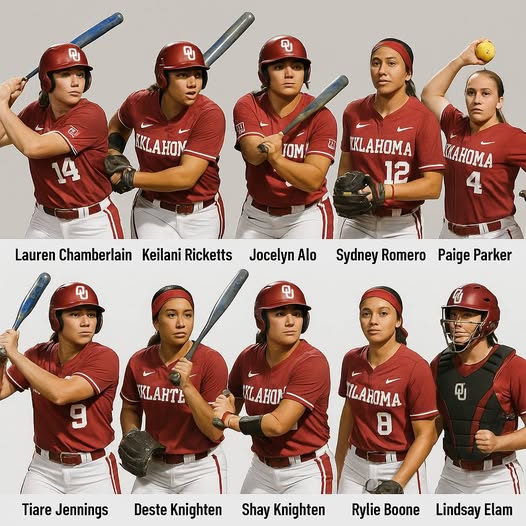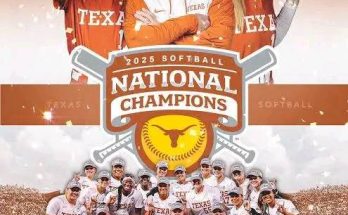Oklahoma didn’t just dominate college softball—they rewrote the rules. From jaw-dropping home runs to clutch strikeouts that silenced entire stadiums, these Sooner legends didn’t just play the game—they changed it.
For the past decade, the Oklahoma Sooners have stood as a towering force in NCAA softball, transforming not just their program but the very landscape of the sport. Their story isn’t just about wins—though there have been plenty—it’s about dominance so complete that it made other teams recalibrate their programs, coaches rethink their strategies, and fans reimagine what was possible on the diamond. Oklahoma didn’t merely set the bar; they moved it beyond sight. And in doing so, they became more than a team. They became a phenomenon.
The dynasty began building years before the trophies started piling up. Patty Gasso, the architect of it all, took over a program in 1995 that was respectable but far from elite. With time, patience, and relentless standards, she molded Oklahoma into a machine of excellence. By the early 2010s, the Sooners were no longer just contenders—they were kings and queens of the sport. It wasn’t just about having one great season. It was about creating a program where greatness was the standard and winning was the expectation.
From 2016 onward, Oklahoma went on an unprecedented run that college softball had never seen. They didn’t just win national championships; they demolished records and reshaped what it meant to be elite. Behind this run were players who weren’t just stars—they were legends in the making. Lauren Chamberlain’s power at the plate redefined offensive expectations. She was the first player to truly weaponize home runs in a way that forced teams to pitch around her, change rotations, and design game plans specifically for her at-bats. By the time she left Oklahoma, she was the NCAA’s all-time home run leader—a record that symbolized a turning point in how offenses were constructed.
And Chamberlain was just the beginning. Jocelyn Alo, another Oklahoma powerhouse, didn’t just break records—she obliterated them. Her swing was pure fury and balance, her discipline at the plate unmatched. She didn’t just lead Oklahoma to wins—she set the tempo for the entire sport. Alo tied and then broke Chamberlain’s career home run record in an era when pitching had become more dominant and sophisticated. But no pitch was safe. No count was out of reach. When she stepped to the plate, stadiums held their breath. Opposing coaches consulted analytics, sports psychologists, and sometimes just luck, hoping to find a way to slow her down. None succeeded for long.
The power of Oklahoma softball wasn’t confined to their offense. Their pitchers were forces of nature. Paige Parker, Giselle Juarez, and Jordy Bahl weren’t just throwers—they were sculptors of silence. They made entire stadiums go mute with one strikeout after another. Parker’s stoic dominance, Juarez’s late-inning fire, and Bahl’s fierce intensity became signature Oklahoma trademarks. Their performances on the mound didn’t just win games—they dictated tone and tempo, crushed momentum, and instilled dread in opposing dugouts.
But the real revolution Oklahoma sparked came from how they approached every element of the game. They didn’t just hit and pitch better. They practiced differently, they trained smarter, and they brought a level of psychological preparation that bordered on professional. They turned the dugout into a live wire of energy and focus. They choreographed cheers and routines that turned mental toughness into a culture. There was no panic in pressure. Oklahoma didn’t just survive high-stakes moments—they lived in them.
Recruiting changed in response to Oklahoma’s dominance. High school players no longer just dreamed of playing in the Women’s College World Series—they dreamed of wearing crimson and cream. The Sooners’ brand became synonymous with excellence, and that brand extended far beyond the Midwest. Players from California, Florida, Hawaii, and everywhere in between looked to Norman as the epicenter of college softball. The ripple effect was enormous. Other programs began pouring resources into recruiting, training, and development, trying to mirror the Oklahoma model. Even perennial powers like UCLA, Arizona, and Florida had to step up their game.
What set Oklahoma apart, though, wasn’t just that they had better players. It was that they had built a system that turned talent into performance and performance into legacy. Their defense, often overshadowed by towering home runs and strikeouts, was razor-sharp. Infielders with cat-like reflexes and outfielders who turned would-be doubles into outs made sure pitchers never felt like they had to be perfect—though they often were.
Behind it all stood Patty Gasso, the mastermind of the machine. Gasso’s ability to evolve with the game, to blend old-school grit with new-age analytics, made her a coaching icon. She didn’t just recruit skill—she recruited character. Her teams didn’t crack under pressure; they performed at their best when everything was on the line. She turned under-recruited players into All-Americans, and five-star athletes into generational talents. Her culture of accountability, unity, and relentless excellence set the foundation for everything the program became.
Oklahoma’s impact reached beyond the lines of the field. As their dynasty grew, so did the visibility of the sport. Attendance records shattered. TV ratings soared. The Women’s College World Series turned into a marquee national event, fueled in large part by Oklahoma’s presence. Fans didn’t just watch to see if the Sooners would win—they watched to see how they would do it. Would it be a walk-off home run? A no-hitter? A seven-run first inning? The possibilities were always thrilling and endless.
Social media turned Sooner stars into household names. Highlights of Alo’s moonshot home runs or Bahl’s emotional strikeouts went viral. Young girls across the country watched and saw themselves in those players. Oklahoma didn’t just win championships—they inspired a generation. Camps in Norman sold out. Little league teams mimicked their cheers. Suddenly, softball wasn’t just a springtime sideshow—it was a central pillar of college sports excitement.
And then there was the standard they set. Going undefeated in a season used to be an outlandish fantasy. Oklahoma made it look inevitable. From 2021 through 2023, they went on historic win streaks, some reaching into the 50s—an unfathomable feat in a sport as unpredictable as softball. Every game brought questions not of “if” they would win, but “how much” and “how fast.” Mercy rules became routine. Their average margin of victory sometimes looked like a football score.
And yet, for all their dominance, they never coasted. Every year brought new challenges. Graduation took legends, the transfer portal reshuffled rosters, and opposing teams came armed with better game plans and more firepower. But year after year, Oklahoma adjusted, adapted, and kept winning. They showed that excellence isn’t a moment—it’s a lifestyle. They didn’t wait for greatness to happen. They demanded it, and they delivered.
The Sooners redefined what a dynasty looks like in women’s college sports. While basketball had UConn and tennis had Stanford, softball now had Oklahoma—a team whose sheer brilliance and brutal efficiency changed what the sport looked like at its highest level. They forced the NCAA to take women’s sports more seriously, to invest more, to broadcast more games, to build better facilities, to elevate the game. And all of that started in Norman.
As we look back on the Oklahoma dynasty, we’re not just celebrating a collection of wins. We’re recognizing a cultural shift. The Sooners made it clear that dominance in women’s sports isn’t just possible—it’s marketable, watchable, and inspirational. They shattered ceilings, broke records, and silenced doubters, all while carrying the banner of excellence with pride. They weren’t perfect. But they were relentless, unshakable, and unforgettable.
Oklahoma didn’t just dominate college softball—they rewrote its language, recast its legends, and reimagined what was possible. In doing so, they didn’t just become the best team of their era. They became a defining force in the history of college athletics.



